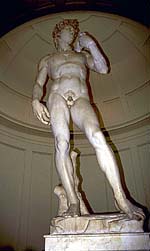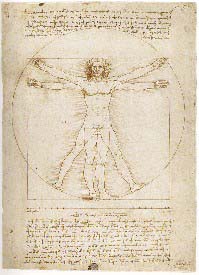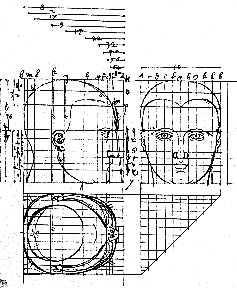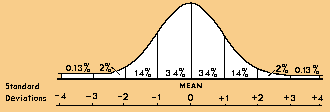|
Human proportion: average vs ideal (Galton)
Following Quételet, Sir Francis Galton (1822 – 1911), English scientist, explorer and anthropometrist, showed that if any set of measurements within a population (e.g. the heights of all people) is normally distributed, then so are sets of similar measurements of any subgroup of that population, and vice versa. He showed too there is a correlation between the measurements of different parts of the body.
For example, for white U.S. males aged 18 to 30 years, the relationship between the height of a person and the length of the upper arm bone (humerus) is
y = 3.08x + 70.45, where y = height in cms and x = length of humerus in cms.
For white U.S. females aged 18 to 30 years, the relationship is y = 3.36x + 57.97.
The expected or standard error for males is ± 4.05 cms, for females, ± 4.45 cms.
Such relationships are important in forensic pathology and anthropology as a means of predicting the likely height and other characteristics of a body from bone measurements. More widely, such data are critical in ergonomics: the size and shape of the ‘average person’ are important in designing human environments and equipment.It is interesting to ponder whether a person of the proportions of Michelangelo’s David would be comfortable in today’s world!
|


 The skyline is dominated by the immense dome of the cathedral (Duomo) and its bell tower, and the tower of the town hall (Palazzo Vecchio). This city of 500 000 people, a major centre of art and learning in Italy, was home to Leonardo da Vinci, Raphael and Michelangelo.
The skyline is dominated by the immense dome of the cathedral (Duomo) and its bell tower, and the tower of the town hall (Palazzo Vecchio). This city of 500 000 people, a major centre of art and learning in Italy, was home to Leonardo da Vinci, Raphael and Michelangelo. Michelangelo and David
Michelangelo and David David and human proportion (I)
David and human proportion (I) Leonardo and human proportion
Leonardo and human proportion ‘A magnificent temple cannot be constructed properly, unless it is built in an orderly manner with regard to symmetry and proportion of its parts, as is the case with a well-built man. For the human body is designed by nature, put together and created so that the head from the chin to the hairline measures one tenth of the entire body. Likewise the flat or extended hand from the wrist to the tip of the middle finger is equal to the distance from the chin to the part of the hair, i.e. one eighth part. Likewise from the bottom of the neck and the high point of the chest to the hairline, one sixth; and to the top of the head, one quarter.
‘A magnificent temple cannot be constructed properly, unless it is built in an orderly manner with regard to symmetry and proportion of its parts, as is the case with a well-built man. For the human body is designed by nature, put together and created so that the head from the chin to the hairline measures one tenth of the entire body. Likewise the flat or extended hand from the wrist to the tip of the middle finger is equal to the distance from the chin to the part of the hair, i.e. one eighth part. Likewise from the bottom of the neck and the high point of the chest to the hairline, one sixth; and to the top of the head, one quarter.  But to the level of the mouth, one third; from the tip of the chin to the nose, from the tip of the nose to the midpoint of the eyebrows, and thence to the root of the hair, each one third. The length of the foot is one sixth of the body length, the forearm one quarter, the chest one quarter. In this manner all other limbs have their proportional measurements, which were observed by ancient painters and sculptors.’
But to the level of the mouth, one third; from the tip of the chin to the nose, from the tip of the nose to the midpoint of the eyebrows, and thence to the root of the hair, each one third. The length of the foot is one sixth of the body length, the forearm one quarter, the chest one quarter. In this manner all other limbs have their proportional measurements, which were observed by ancient painters and sculptors.’ Dürer and human proportion
Dürer and human proportion 34 heights lie between the mean and +1 standard deviation (d.v.) from the mean,
34 heights lie between the mean and +1 standard deviation (d.v.) from the mean,